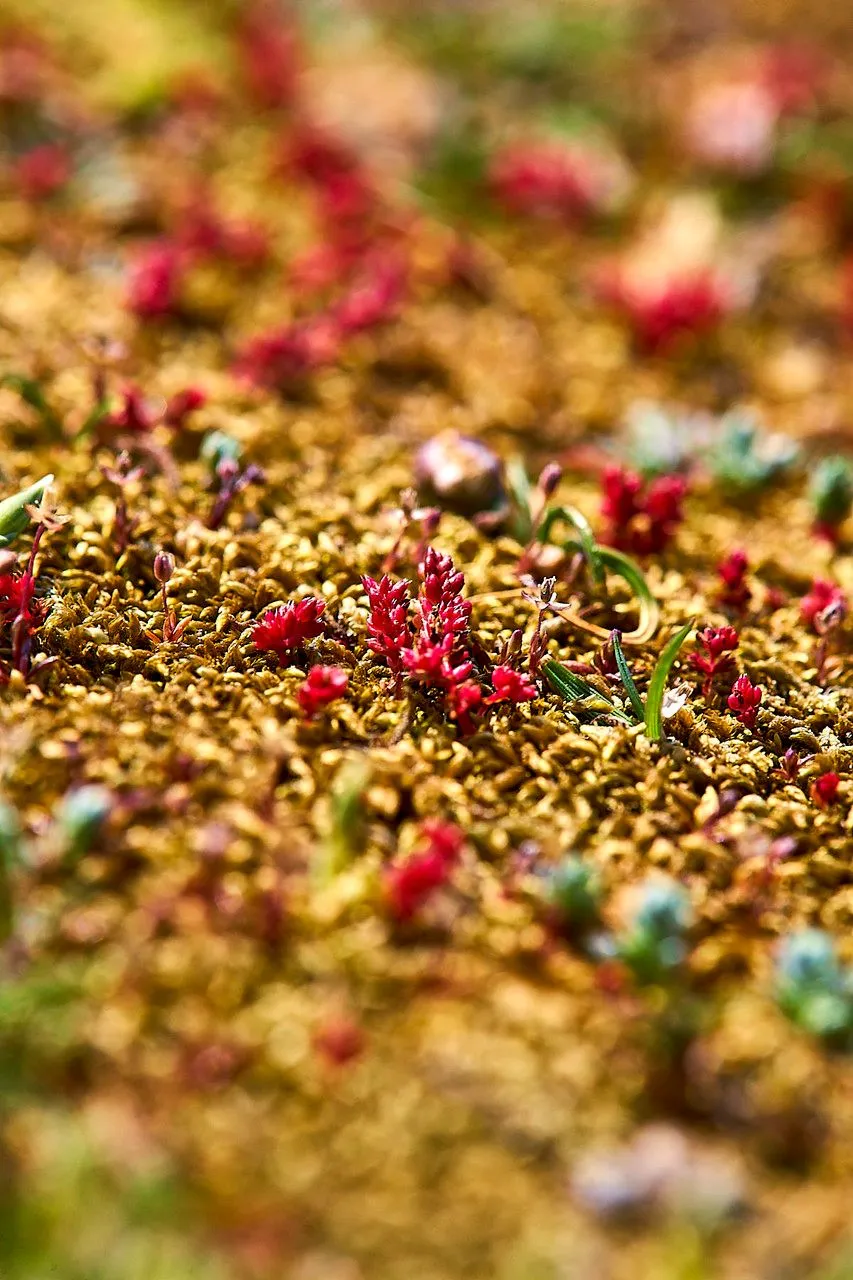
Author: Lest.-Garl.
Bibliography: Fl. Jersey: 87 (1903)
Year: 1903
Status: accepted
Rank: species
Genus: Crassula
Vegetable: False
Observations: Macaronesia, Europe, Medit.
Mossy-stonecrop, known scientifically as Crassula tillaea, is a captivating member of the Crassulaceae family. This diminutive yet resilient plant has captured the interest of botanists and plant enthusiasts alike due to its unique characteristics and widespread distribution.
First documented in 1903 in the “Flora of Jersey” on page 87 by the esteemed botanist Lestiboudois-Garrel, Crassula tillaea showcases the intricate beauty of the natural world. The mossy-stonecrop boasts a distinctive appearance—typically forming dense, moss-like matting that blankets the ground. Its small, fleshy leaves, which are often tinged with a reddish hue, add a splash of color to the environments it adorns.
One of the most remarkable features of Crassula tillaea is its geographical range. This hardy plant is native to the regions of Macaronesia, Europe, and the Mediterranean, thriving in a variety of climates and habitats. It favors well-drained soils and often grows in rocky or sandy areas, where it can form thick ground cover. Its ability to endure in less-than-ideal conditions makes it an excellent plant for xeriscaping and other landscape designs aimed at conserving water.
Despite its modest size, mossy-stonecrop plays a significant role in its ecosystem. It provides ground cover that helps to prevent soil erosion, and its presence enhances the local biodiversity by offering habitat and food sources for various small insects and microorganisms.
Gardening enthusiasts appreciate Crassula tillaea for its low maintenance needs and its ability to spread readily, creating charming carpets of vegetation in rock gardens, borders, and container plantings. Its adaptability to different environmental conditions, coupled with its aesthetic appeal, makes it a popular choice for those looking to incorporate hardy yet attractive plants into their green spaces.
In summary, Crassula tillaea is more than just a plant; it is a testament to nature’s adaptability and beauty. This mossy-stonecrop not only contributes to the ecological balance of its native regions but also enchants all who encounter its unique charm.
Spa: crasula de tilli
Deu: moos-dickblatt, moosdickblatt
Eng: moss pygmyweed, mossy stonecrop, mossy-stonecrop, mossy tillaea, tilliwort
Nld: mosbloempje
Fra: mousse fleurie, tillée mousse, crassule mousse, mousse-fleurie
Swe: mosskrassula
Cym: anwywig, corchwyn mwsoglog, tilaea
Ita: erba grassa muscosa
En: Mossy-stonecrop, Moss pygmyweed, Mossy Stonecrop, Mossy tillaea, Tilliwort
Bg: Дебололист
Ca: Til·lea
Kw: Les kewni
Nl: Mosbloempje
Fi: Sammalpaunikko
Fr: Crassule Mousse, Mousse fleurie, Tillée mousse, Mousse-fleurie
De: Moos-Dickblatt, Moosblümchen, Moosdickblatt
It: Erba grassa muscosa
Es: Crasula de tilli
Sv: Mosskrassula
Cy: Anwywig, Corchwyn Mwsoglog, Tilaea
Taken Nov 30, 2020 by Koga Lissa (cc-by-sa)
Taken Feb 6, 2020 by Caetano Mayana (cc-by-sa)
Taken Dec 23, 2021 by Bachtiar Yudi (cc-by-sa)
Taken Nov 20, 2021 by Nathalie Kassimi (cc-by-sa)
Taken Apr 27, 2017 by Tela Botanica − Liliane ROUBAUDI (cc-by-sa)
Taken May 24, 2015 by Tela Botanica − Liliane ROUBAUDI (cc-by-sa)
Taken Mar 6, 2016 by Tela Botanica − Genevieve BOTTI (cc-by-sa)
Taken Apr 15, 2021 by Aurélia et JChris Courte-Barbary (cc-by-sa)
Taken Mar 26, 2018 by Llandrich anna (cc-by-sa)
Taken Apr 1, 2021 by jean-christophe courte (cc-by-sa)
Taken Mar 18, 2021 by Antonio Rodríguez Franco (cc-by-sa)
Taken Jul 3, 2012 by Tela Botanica − Emmanuel STRATMAINS (cc-by-sa)
Taken Apr 5, 2021 by Lynn (cc-by-sa)
Taken Apr 15, 2021 by Aurélia et JChris Courte-Barbary (cc-by-sa)
Taken Apr 15, 2004 by Photoflora – Jean-Luc TASSET (©)
Taken Apr 15, 1998 by Photoflora – Benoit BOCK (©)
Taken Feb 15, 2006 by Photoflora – Jean-Luc TASSET (©)
Taken Jan 1, 1970 by Photoflora – L’Abbé COSTE (©)
Taken Apr 30, 1851 by Tela Botanica − Herbier PONTARLIER-MARICHAL (cc-by-sa)
Taken Apr 7, 2022 by Llandrich anna (cc-by-sa)
Taken Jun 30, 2020 by Groupe Botanique de Bruxelles (cc-by-sa)
Taken Jun 30, 2020 by Groupe Botanique de Bruxelles (cc-by-sa)
Taken Nov 24, 2020 by Antonello D’Angelo (cc-by-sa)
Taken Feb 21, 2021 by Benjamin Lippert (cc-by-sa)
Taken Feb 6, 2021 by Christian DENIS (cc-by-sa)
Taken Apr 4, 2015 by Tela Botanica − Errol Vela (cc-by-sa)
© copyright of the Board of Trustees of the Royal Botanic Gardens, Kew.
© copyright of the Board of Trustees of the Royal Botanic Gardens, Kew.
© copyright of the Board of Trustees of the Royal Botanic Gardens, Kew.
Growth habit: Forb/herb
Bloom months: [‘apr’, ‘may’, ‘jun’]
Family: Myrtaceae Author: (F.Muell.) K.D.Hill & L.A.S.Johnson Bibliography: Telopea 6: 402 (1995) Year: 1995 Status:…
Family: Rubiaceae Author: Pierre ex A.Froehner Bibliography: Notizbl. Bot. Gart. Berlin-Dahlem 1: 237 (1897) Year:…
Family: Sapindaceae Author: Koidz. Bibliography: J. Coll. Sci. Imp. Univ. Tokyo 32(1): 38 (1911) Year:…
Family: Asteraceae Author: A.Gray Bibliography: Pacif. Railr. Rep.: 107 (1857) Year: 1857 Status: accepted Rank:…
Family: Fabaceae Author: Medik. Bibliography: Vorles. Churpfälz. Phys.-Ökon. Ges. 2: 398 (1787) Year: 1787 Status:…
Family: Aspleniaceae Author: (Cav.) Alston Bibliography: Bull. Misc. Inform. Kew 1932: 309 (1932) Year: 1932…